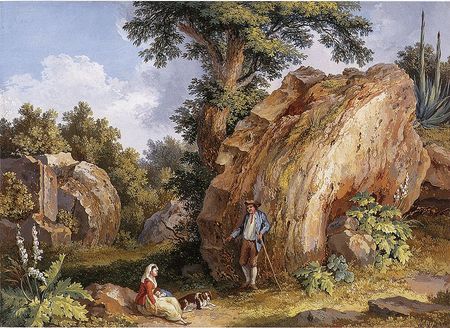"Jakob Philipp Hackert. European Landscape Painters in the Age of Goethe" @ the Hamburger Kunsthalle
Jakob Philipp Hackert (1737-1807), Die Wasserfälle von Tivoli, 1785, Öl auf Leinwand, 122,5 x 171 cm. © Hamburger Kunsthalle / bpkPhoto: Elke Walford
HAMBURG.- Jakob Philipp Hackert (1737–1807) regarded landscapes as natural events, and his precisely observed depictions of geological and atmospheric phenomena marked a turning point in 18th-century landscape painting. For the first time, a comprehensive exhibition of Hackert’s work is being presented at the Hamburger Kunsthalle in cooperation with the Klassik Stiftung Weimar (Foundation of Weimar Classics).
Despite being famous during his own lifetime and held in high regard by Goethe, Hackert is one of the artists from the period around 1800 who was later largely forgotten, and it is only recently that his work has attracted renewed interest. Following his training in Berlin and stays in Sweden and France, he spent the greater part of his life working in Italy. Here he established his reputation as an internationally acclaimed artist and contributed greatly to shaping the image of Italy before 1800. Besides veduta, harbour views and hunting scenes, Hackert above all painted atmospheric landscapes in the Roman Campagna, Tuscany and parts of Southern Italy such as Naples and Sicily.
The world in which Hackert lived was still strongly influenced by the feudalistic splendour of the Ancien Régime, which was swept aside when French revolutionary troops invaded Naples. At the same time, however, he was already an extremely efficient, market-orientated and business-minded artist who was able to operate largely independently of hierarchical court structures, and as such he anticipated modern artistic positions of the 19th century. While Hackert’s landscapes – ideal compositions augmented with historicising staffage or ancient sites – make him an important forerunner and representative of the classical conception of art, he also breached the established criteria of this rigorously idealised vision of art with his topographically accurate set pieces and precise rendering of carefully observed natural details.
In this way Hackert also provided a starting point for the next generation of artists. His interest in natural phenomena, in the depiction of waterfalls, volcanic eruptions or mountain gorges – combining landscape painting with the natural sciences through the detailed study of geological and atmospheric phenomena – found logical continuation in the work of various other artists. Around 70 paintings and 70 works on paper, on loan from collections throughout Europe, will give a representative overview of Hackert’s diverse œ uvre. Exhibition curator: Dr. Andreas Stolzenburg.
28 November 2008 to 15 February 2009
Jakob Philipp Hackert (1737-1807), Blick auf den Ätna, 1783 © München, Privatsammlung
Jakob Philipp Hackert (1737-1807). Die Ruine des Olympeions in Agrigent, 1778 © Leipzig, Museum der Bildenden Künste, Graphische Sammlung
Jakob Philipp Hackert (1737-1807). Venustempel in Baie, 1798 © Staatliche Museen zu Berlin, Alte Nationalgalerie
Jakob Philipp Hackert (1737-1807). Die Küste bei Vietri, 1770 © Hamburger Kunsthalle, Kupferstichkabinett. Photo: Elke Walford

/https%3A%2F%2Fprofilepics.canalblog.com%2Fprofilepics%2F1%2F0%2F100183.jpg)
/https%3A%2F%2Fstorage.canalblog.com%2F03%2F02%2F119589%2F96711876_o.jpg)
/https%3A%2F%2Fstorage.canalblog.com%2F11%2F31%2F119589%2F94773502_o.jpg)
/https%3A%2F%2Fstorage.canalblog.com%2F20%2F83%2F119589%2F94772815_o.jpg)
/https%3A%2F%2Fstorage.canalblog.com%2F26%2F72%2F119589%2F75604929_o.jpg)
/https%3A%2F%2Fstorage.canalblog.com%2F59%2F60%2F119589%2F26458628_o.jpg)







/http%3A%2F%2Fstorage.canalblog.com%2F89%2F79%2F119589%2F29775832_o.jpg)
/image%2F1371349%2F20240418%2Fob_ac5c4c_telechargement.jpg)
/image%2F1371349%2F20240418%2Fob_709b64_304-1.jpg)
/image%2F1371349%2F20240418%2Fob_22f67e_303-1.jpg)